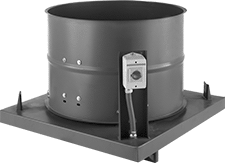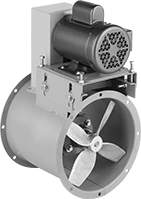About Exhaust Fans
More
About Sound Levels
Measured in decibels (dB), volume ratings indicate how much noise equipment makes. Some common volume levels include a whisper @ 20 dB, a refrigerator @ 40 dB, a conversation @ 60 dB, and a light machine shop @ 90 dB. OSHA recommends hearing protection for exposure to 80 dB and greater.
Direct-Drive Upblast Roof-Mount Exhaust Fans

Direct-drive fans have fewer moving parts than belt-drive fans for less maintenance. These exhaust fans draw stagnant and humid air out through your roof and then expel it up and away from the roof surface. All fans have a disconnect switch to turn off the power for servicing.
Note: Airflow depends on the resistance created by ductwork. This resistance, known as static pressure (SP), is measured in inches of water.
Fans | |||||||||||||||
|---|---|---|---|---|---|---|---|---|---|---|---|---|---|---|---|
Overall | Mounting Bases | ||||||||||||||
| Blade Dia. | Airflow @ Static Pressure | Volume | Motor Speed, rpm | Power, hp | Dia. | Ht. | Base Wd. | Wt., lbs. | Max. Ambient Temp., °F | Housing Material | Each | Each | |||
Totally Enclosed Motor Enclosure | |||||||||||||||
460V AC, Three Phase—Hardwire | |||||||||||||||
| 2 | 48" | 25,500 cfm @ 1/2 in. of H₂O 34,300 cfm @ 0 in. of H₂O | 76 dBA @ 5 ft. | 1,150 | 5 | 56" | 38 3/4" | 60" | 650 | 120° | Steel | 0000000 | 000000000 | 0000000 | 0000000 |
Belt-Drive Corrosion-Resistant Duct Fans

A 304 stainless steel housing offers good corrosion resistance. All of these belt-drive fans are quieter and have a longer life span than direct-drive fans because components can be replaced if worn or damaged. They install inline in ductwork for use as an exhaust, supply, or booster fan. The fans have a totally enclosed motor enclosure, which can be used in dirty, dusty, and damp environments.
Note: Airflow depends on the resistance created by ductwork. This resistance, known as static pressure (SP), is measured in inches of water.
Overall | ||||||||||||||
|---|---|---|---|---|---|---|---|---|---|---|---|---|---|---|
| For Duct Dia. | Airflow @ Static Pressure | Volume | Motor Speed, rpm | Power, hp | Dia. | Ht. | Dp. | Max. Temp., °F | Housing Material | Blade Material | Mounting Fasteners Included | Mounting Hole Dia. | Each | |
230/460V AC, Three Phase—Hardwire | ||||||||||||||
| 24" | 7,200 cfm @ 3/8 in. of H₂O 7,900 cfm @ 1/8 in. of H₂O | 65 dBA @ 15 ft. | 1,700 | 2 | 26 11/16" | 38 3/4" | 21" | 200° | 304 Stainless Steel | Stainless Steel | No | 7/16" | 0000000 | 000000000 |

























